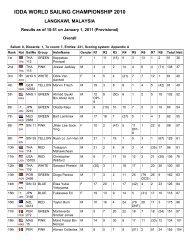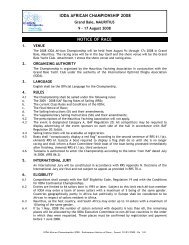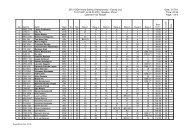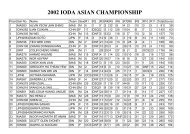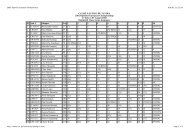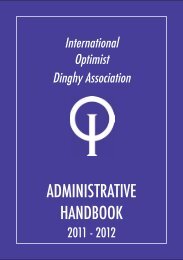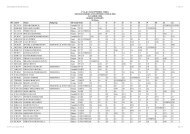2011 INTERNATIONAL OPTIMIST CLASS RULES
2011 INTERNATIONAL OPTIMIST CLASS RULES
2011 INTERNATIONAL OPTIMIST CLASS RULES
Create successful ePaper yourself
Turn your PDF publications into a flip-book with our unique Google optimized e-Paper software.
For the purpose of positioning and fixing, the top of the daggerboard case, the flanges<br />
of the midship frame-daggerboard case assembly and the flanges of the mast thwart<br />
bulkhead shall consist of min 3 x 450 / max 5 x 450 mat (min 3 mm / max 8 mm thickness).<br />
At this top and these flanges, the distribution of glass content and the thickness<br />
of the laminate need not be uniform throughout..<br />
(g) Gunwale laminate, incl. Thickness : max 4 mm<br />
rubbing strake.<br />
Mould side gel coat<br />
450 mat<br />
450 mat<br />
450 mat<br />
3.2.4 Construction Details - Wood: See Appendix A<br />
3.2.5 Rule no. not used.<br />
3.2.6 Fittings<br />
300 woven cloth as supporting reinforcement between inner<br />
hull sides and inner gunwale (see GRP plan sheets 3), except<br />
forward of the mast thwart bulkhead. Gaps of up to 55 mm<br />
wide are permitted at the aft corners, at each side of the side<br />
members and at the aft side of the mast thwart bulkhead. The<br />
width of this reinforcement shall be 50 mm +/- 5 mm.<br />
3.2.6.1 The following fittings are permitted:<br />
(a) 2 Mainsheet blocks (excluding those on the boom) shall be attached to the hull<br />
inner bottom. The centre of their fixing points shall be at 786 mm +/- 5 mm and<br />
894 mm +/- 5 mm from the forward face of the aft transom.<br />
(b) One ratchet block for the mainsheet.<br />
(c) 2 toe-straps and 4 associated fixing plates of 50 mm +/- 10 mm x 20 mm +/- 5mm<br />
x 2 mm +/- 1mm if metal or 50 mm +/- 10 mm x 20 mm +/- 5 mm x 7 mm +/- 3 mm<br />
if plastic. (see also CR 3.2.6.2 and CR 3.2.7.3) Up to three pieces of cord or elastic<br />
cord may be used to lift the toe-straps off the hull shell floor.<br />
(d) A compass and associated fixings, which shall all be removable for weighing the hull.<br />
Mobile phones, digital compasses and/or devices memorising, correlating or transmitting<br />
data relative to wind direction or speed, or boat speed or direction and location are<br />
not permitted, unless these devices are supplied by the Organising Authority for the<br />
sole purpose of providing event tracking.<br />
(e) Retaining clip(s) for a paddle.<br />
(f) An adjustable mast step. Movement of the mast at the mast step or at the passage of the<br />
mast through the mast thwart shall not be able to exceed 3 mm in any horizontal direction.<br />
The mast or mast step shall not be adjusted while racing. Mast step devices which can be<br />
easily set while racing in such a way that this class rule is infringed, are prohibited.<br />
(g) Retaining clips for water bottles, food container or other personal equipment,<br />
which shall be removable for weighing the hull.<br />
(h) Retaining clip for fastening the tiller extension to the tiller.<br />
(i) Strips of non-metallic material may be fitted in the daggerboard slot within 30 mm of<br />
the top and the bottom of the slot to achieve a uniform opening of 16 mm +/- 2 mm<br />
at the top and the bottom of the slot. Additional non-metallic material may be placed<br />
within 30 mm of each end of the top and bottom of the slot to act as positioning and<br />
protection of the daggerboard. This additional material shall be removed upon<br />
request of the measurer, for the measurement of the slot. (see also CR 3.2.2.11)<br />
(j) A handle or ball may be used on the outer end of:<br />
(i) Sprit halyard.<br />
(ii) Boom downhaul.<br />
12



